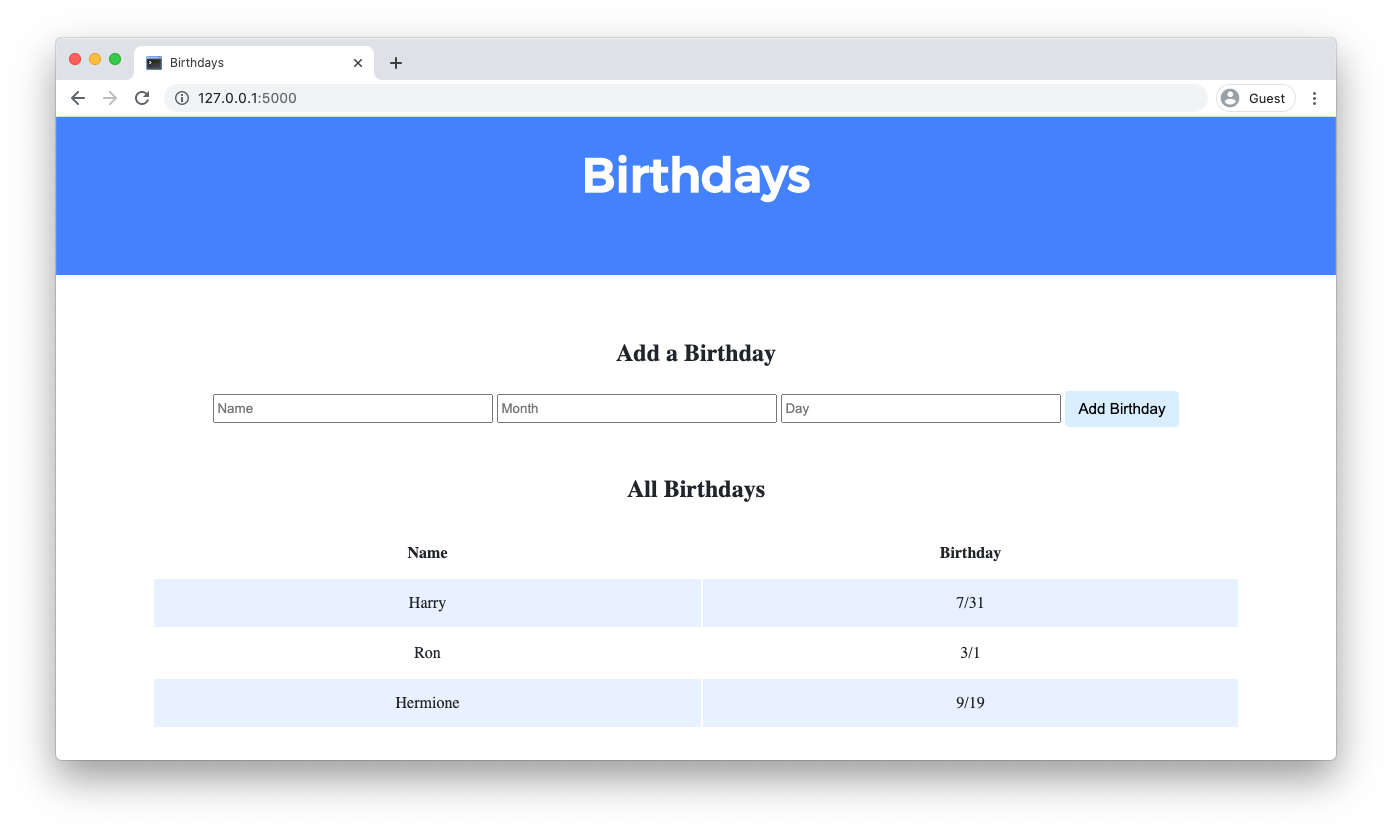Lab 9: Birthdays
You are welcome to collaborate with one or two classmates on this lab, though it is expected that every student in any such group contribute equally to the lab.
Create a web application to keep track of friends’ birthdays.

Getting Started
Started CS50x in 2021 or prior and need to migrate your work from CS50 IDE to the new VS Code codespace? Be sure to check out our instructions on how to migrate your files!
Open VS Code.
Start by clicking inside your terminal window, then execute cd by itself. You should find that its “prompt” resembles the below.
$
Click inside of that terminal window and then execute
wget https://cdn.cs50.net/2021/fall/labs/9/birthdays.zip
followed by Enter in order to download a ZIP called birthdays.zip in your codespace. Take care not to overlook the space between wget and the following URL, or any other character for that matter!
Now execute
unzip birthdays.zip
to create a folder called birthdays. You no longer need the ZIP file, so you can execute
rm birthdays.zip
and respond with “y” followed by Enter at the prompt to remove the ZIP file you downloaded.
Now type
cd birthdays
followed by Enter to move yourself into (i.e., open) that directory. Your prompt should now resemble the below.
birthdays/ $
If all was successful, you should execute
ls
and you should see the following files and folders:
app.py birthdays.db static/ templates/
If you run into any trouble, follow these same steps again and see if you can determine where you went wrong!
Understanding
In app.py, you’ll find the start of a Flask web application. The application has one route (/) that accepts both POST requests (after the if) and GET requests (after the else). Currently, when the / route is requested via GET, the index.html template is rendered. When the / route is requested via POST, the user is redirected back to / via GET.
birthdays.db is a SQLite database with one table, birthdays, that has four columns: id, name, month, and day. There are a few rows already in this table, though ultimately your web application will support the ability to insert rows into this table!
In the static directory is a styles.css file containing the CSS code for this web application. No need to edit this file, though you’re welcome to if you’d like!
In the templates directory is an index.html file that will be rendered when the user views your web application.
Implementation Details
Complete the implementation of a web application to let users store and keep track of birthdays.
- When the
/route is requested viaGET, your web application should display, in a table, all of the people in your database along with their birthdays.- First, in
app.py, add logic in yourGETrequest handling to query thebirthdays.dbdatabase for all birthdays. Pass all of that data to yourindex.htmltemplate. - Then, in
index.html, add logic to render each birthday as a row in the table. Each row should have two columns: one column for the person’s name and another column for the person’s birthday.
- First, in
- When the
/route is requested viaPOST, your web application should add a new birthday to your database and then re-render the index page.- First, in
index.html, add an HTML form. The form should let users type in a name, a birthday month, and a birthday day. Be sure the form submits to/(its “action”) with a method ofpost. - Then, in
app.py, add logic in yourPOSTrequest handling toINSERTa new row into thebirthdaystable based on the data supplied by the user.
- First, in
Optionally, you may also:
- Add the ability to delete and/or edit birthday entries.
- Add any additional features of your choosing!
Walkthrough
This video was recorded when the course was still using CS50 IDE for writing code. Though the interface may look different from your codespace, the behavior of the two environments should be largely similar!
Hints
- Recall that you can call
db.executeto execute SQL queries withinapp.py.- If you call
db.executeto run aSELECTquery, recall that the function will return to you a list of dictionaries, where each dictionary represents one row returned by your query.
- If you call
- You’ll likely find it helpful to pass in additional data to
render_template()in yourindexfunction so that access birthday data inside of yourindex.htmltemplate. - Recall that the
trtag can be used to create a table row and thetdtag can be used to create a table data cell. - Recall that, with Jinja, you can create a
forloop inside yourindex.htmlfile. - In
app.py, you can obtain the dataPOSTed by the user’s form submission viarequest.form.get(field)wherefieldis a string representing thenameattribute of aninputfrom your form.- For example, if in
index.html, you had an<input name="foo" type="text">, you could userequest.form.get("foo")inapp.pyto extract the user’s input.
- For example, if in
Not sure how to solve?
Testing
No check50 for this lab! But be sure to test your web application by adding some birthdays and ensuring that the data appears in your table as expected.
Run flask run in your terminal while in your birthdays directory to start a web server that serves your Flask application.
How to Submit
In your terminal, execute the below to submit your work.
submit50 cs50/labs/2022/x/birthdays